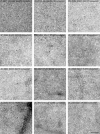Relationship between foveal cone specialization and pit morphology in albinism
- PMID: 24845642
- PMCID: PMC4098060
- DOI: 10.1167/iovs.13-13217
Relationship between foveal cone specialization and pit morphology in albinism
Abstract
Purpose: Albinism is associated with disrupted foveal development, though intersubject variability is becoming appreciated. We sought to quantify this variability, and examine the relationship between foveal cone specialization and pit morphology in patients with a clinical diagnosis of albinism.
Methods: We recruited 32 subjects with a clinical diagnosis of albinism. DNA was obtained from 25 subjects, and known albinism genes were analyzed for mutations. Relative inner and outer segment (IS and OS) lengthening (fovea-to-perifovea ratio) was determined from manually segmented spectral domain-optical coherence tomography (SD-OCT) B-scans. Foveal pit morphology was quantified for eight subjects from macular SD-OCT volumes. Ten subjects underwent imaging with adaptive optics scanning light ophthalmoscopy (AOSLO), and cone density was measured.
Results: We found mutations in 22 of 25 subjects, including five novel mutations. All subjects lacked complete excavation of inner retinal layers at the fovea, though four subjects had foveal pits with normal diameter and/or volume. Peak cone density and OS lengthening were variable and overlapped with that observed in normal controls. A fifth hyper-reflective band was observed in the outer retina on SD-OCT in the majority of the subjects with albinism.
Conclusions: Foveal cone specialization and pit morphology vary greatly in albinism. Normal cone packing was observed in the absence of a foveal pit, suggesting a pit is not required for packing to occur. The degree to which retinal anatomy correlates with genotype or visual function remains unclear, and future examination of larger patient groups will provide important insight on this issue.
Keywords: adaptive optics; albinism; foveal development; foveal morphology.
Copyright 2014 The Association for Research in Vision and Ophthalmology, Inc.
Figures





Comment in
-
Relationship between foveal cone specialization and pit morphology in albinism.Invest Ophthalmol Vis Sci. 2014 Sep 18;55(9):5922. doi: 10.1167/iovs.14-15383. Invest Ophthalmol Vis Sci. 2014. PMID: 25237179 No abstract available.
-
Author response: relationship between foveal cone specialization and pit morphology in albinism.Invest Ophthalmol Vis Sci. 2014 Sep 18;55(9):5923. doi: 10.1167/iovs.14-15470. Invest Ophthalmol Vis Sci. 2014. PMID: 25237180 Free PMC article. No abstract available.
References
-
- King RA, Pietsch J, Fryer JP, et al. Tyrosinase gene mutations in oculocutaneous albinism 1 (OCA1): definition of the phenotype. Hum Genet. 2003; 113: 502–513 - PubMed
-
- Oetting WS, King RA. Molecular basis of albinism: mutations and polymorphisms of pigmentation genes associated with albinism. Hum Mutat. 1999; 13: 99–115 - PubMed
-
- Oetting WS, Summers CG, King RA. Albinism and the associated ocular defects. Metab Pediatr Syst Ophthalmol. 1994; 17: 5–9 - PubMed
Publication types
MeSH terms
Substances
Grants and funding
- P30EY001931/EY/NEI NIH HHS/United States
- C06-RR016511/RR/NCRR NIH HHS/United States
- UL1 TR000427/TR/NCATS NIH HHS/United States
- R01EY017607/EY/NEI NIH HHS/United States
- R01 EY006109/EY/NEI NIH HHS/United States
- UL1TR000427/TR/NCATS NIH HHS/United States
- R01EY006109/EY/NEI NIH HHS/United States
- R01 EY017607/EY/NEI NIH HHS/United States
- UL1TR000055/TR/NCATS NIH HHS/United States
- T32 EY014537/EY/NEI NIH HHS/United States
- C06 RR016511/RR/NCRR NIH HHS/United States
- P30 EY001931/EY/NEI NIH HHS/United States
- UL1 TR000055/TR/NCATS NIH HHS/United States
- T32EY014537/EY/NEI NIH HHS/United States
LinkOut - more resources
Full Text Sources
Other Literature Sources

